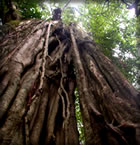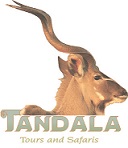 Kakamega Forest covers an area of about 240 square km and was established to protect the only mid altitude tropical rainforest in Kenya, a remnant and eastern limit of rainforests of Zaire and West Africa affinities are unique in Kenya and the forest contains many species found nowhere else in the country.
Kakamega Forest covers an area of about 240 square km and was established to protect the only mid altitude tropical rainforest in Kenya, a remnant and eastern limit of rainforests of Zaire and West Africa affinities are unique in Kenya and the forest contains many species found nowhere else in the country.
The forest lies in the Lake Victoria catchment, about 50km north of Kisumu and just West of the Nandi Escarpment that forms the edge of the central highlands. It was first gazetted as a trust forest in 1933 and two small Nature reserves, Yala and lsecheno were established within the forest in 1967.
Kakamega Forest National Reserve is located in Western Kenya: 15km from Kakamega town along the Kakamega-Eldoret Highway. Access is through the Buyangu gate, which is 600m off the main road. With public transport, visitors can alight at Kambiri junction. Local community cyclists popularly known as “boda boda” offer transport from the junction to the park. If visiting in personal transport, be on the look out for a signpost after 15km from Kakamega town on the highway.
When visiting Kakamega Forest National Reserve, remember this is a tropical rainforest and visitors should be prepared for any sort of weather condition. but for visitors from Europe, it’s not cold in any comparison. Remember also to carry guide books (mammal, bird and butterfly) – some available at the gate house, – insect repellant to keep away insects but not to hate them, a pair of binoculars and for the memories a zoom camera. Don’t forget the tents if you will put up overnight or better still spend in our cosy bandas.
Climate
Annual rainfall is over 2000mm. Most of this rain falls between April and November with a short dry season from December to March. Rain falls mostly in the afternoon or early evening and is often accompanied by heavy thunderstorms. Average temperatures remain similar throughout – between 15 and 28 degrees celcius.
Major attractions
- 300 bird species,
- over 400 species of butterflies,
- over 350 species of trees,
- 27 species of snakes, no history of snake bites since the park started over 20 years ago,
- The endangered Turner’s eremomela, Charpins flycatcher and the voice mimicking African grey parrot,
- endangered DeBrazza monkey found at the isolated Kisere Forest Reserve,
- The majestic black and white colobus monkey alongside flying squirrels, blue monkey and potto (the world’s slowest mammal on earth),
- Forest bucks, duikers and dik diks are found in this equatorial rain forest.
